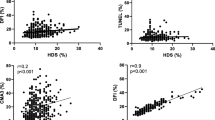Abstract
Purpose: Our purpose was to investigate the associationbetween percentage chromomycin A3 (CMA3) positivity ofspermatozoa with some sperm parameters and in vitrofertilization rate.
Methods: Spermatozoa were collected from 139 men,washed in PBS, fixed in methanol/glacial acetic acid (3:1),and then spread on slides. CMA3 positivity is expressed asthe percentage in 200 spermatozoa.
Results: Percentage of CMA3 positivity showed not only anegative correlation with fertilization rate but also asignificant difference between fertilizing and nonfertilizingpatients. Moreover, percentage of CMA3-positivespermatozoa showed a negative correlation with count and percentagemotility and a positive correlation with percentage ofabnormal morphology. Percentage of CMA3 positivity also had apositive correlation with some abnormalities of head such asamorphous and macrocephaly. Ultrastructural study showedchromatin unpackaging in high CMA3-positive semensamples in comparison with low CMA3-positive semen samples.
Conclusion: There is a close relationship among fertilizationrate, sperm parameters, and CMA3 positivity and CMA3could be considered as a useful tool for evaluation of malefertility prior to infertility treatment.
Similar content being viewed by others
REFERENCES
World Health Organization: Laboratory Manual for the Examination of Human Semen and Semen-Cervical Mucus Interaction, 3rd ed. Cambridge, Cambridge University Press
Mahadevan M, Trounson AO: The influence of seminal characteristics on the success rate of human in vitro fertilization. Fertil Steril 1984;42:400-405
Kruger TF, Menkueld R, Stander FSH, Lombard CJ, et al.: Sperm morphology features as a prognostic factor in in vitro fertilization. Fertil Steril 1986;46:1118-1123.
Liu DY, Duplessis YP, Nayudu PL, et al.: The use of in vitro fertilization to evaluate putative tests of human sperm function. Fertil Steril 1988;49:272-277
Evenson DP, Darzynkiewicz Z, Melamed MR: Relation of mammalian sperm chromatin heterogeneity to fertility. Science 1980;240:1131-1133
Monaco PJ, Rasch EM: Differences in staining with DNA-specific fluorochromes during spermiogenesis. J Histochem Cytochem 1982;30,585
Foresta C, Zorzi M, Rossato M, et al.: Sperm nuclear instability and staining with aniline blue: Abnormal persistence of histones in spermatozoa in infertile men. Int J Androl 1992;15:330-337
Terquem A, Dadoune JP: Aniline blue staining of human spermatozoa chromatin: Evaluation of nuclear maturation. In The Sperm Cell, J Andre (ed). cell. London, Martinus Nijhoff, 1983, pp 696-701
Tejada RI, Mitchell JC, Norman A, et al.: A test for the practical evaluation of male infertility by acridine orange (AO) fluorescence. Fertil Steril 1984;42:87-91
Bianchi PG, Manicardi GC, Urner F, et al.: Chromatin packaging and mrophology in ejaculated human spermatozoa: Evidence of hidden anomalies in normal spermatozoa. Mol Hum Repord 1996;2:139-144
Ward WS, Coffey DS: DNA packaging and organization in mammalian spermatozoa: Comparison with somatic cells. Biol Reprod 1991;44:569-574
Lolis D, Georgiou I, Syrrou M, et al.: ChromomycinA3-staining as an indicator of protamine deficiency and fertilization. Int Androl 1996;19:23-27
Sakkas D, Urner F, Bianchi PG, et al.: Sperm chromatin anomalies can influence decondensation after intracytoplasmic sperm injection. Hum Reprod 1996;11:837-843
Shoukir Y, Chardonnens D, Compana A, et al.: Blastocyst development from supernumerary embryos after intracytoplasmic sperm injection: A paternal influence? Hum Reprod 1998;13:1632-1637
World Health Organization: WHO Laboratory Manual for the Examination of Human Semen and Sperm-Cervical Mucus Interaction, 3rd ed. Cambridge, Cambridge, University Press, 1992
Liu DY, Baker HWG: Sperm nuclear chromatin normality: Relationship with sperm morphology, sperm-zona pellucida binding and fertilization rates in vitro. Fertil Steril 1992; 58:1178-1184
Sailer BL, Jost LK, Evenson DP: Mammalian sperm DNA susceptibility to in situ denaturation associated with the presence of DNA strand breaks as measured by the terminal deoxy-nucleotidyl transferase assay. J Androl 1995;16:80-87
Pousette A, Akerlof E, Rosenborg L, et al.: Increase in progressive motility and improved morphology of human spermatozoa following their migration through percoll gradient. Int J Androl 1986;9:1-13
Oehninger S, Acosta A, Morshedi M, et al.: Corrective measures and pregnancy outcome in in vitro fertilization in patiants with severe sperm morphology abnormalities. Fertil Steril 1988;50:283-287
Author information
Authors and Affiliations
Rights and permissions
About this article
Cite this article
Iranpour, F.G., Nasr-Esfahani, M.H., Valojerdi, M.R. et al. Chromomycin A3 Staining as a Useful Tool for Evaluation of Male Fertility. J Assist Reprod Genet 17, 60–66 (2000). https://doi.org/10.1023/A:1009406231811
Issue Date:
DOI: https://doi.org/10.1023/A:1009406231811




